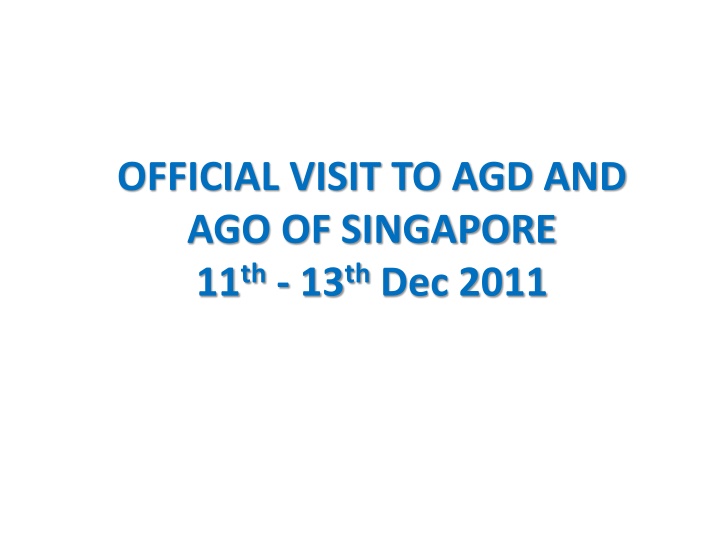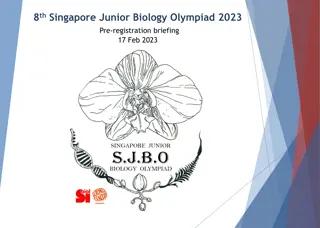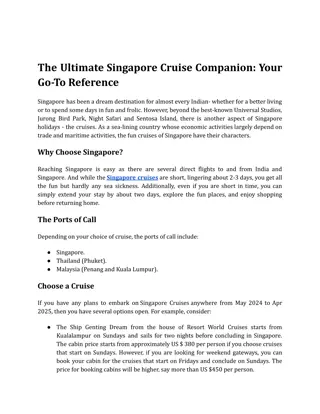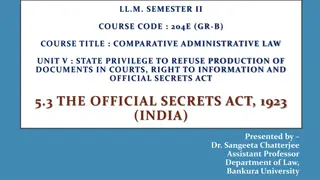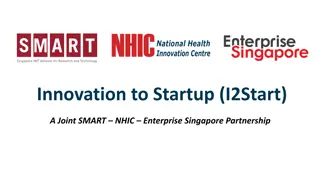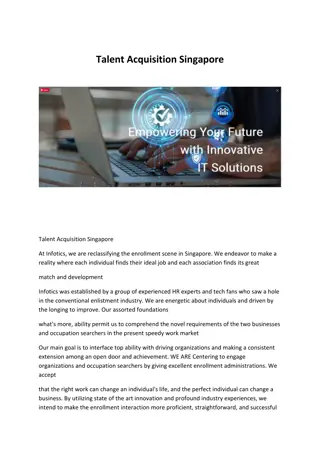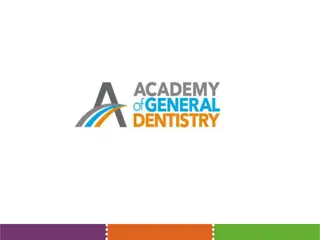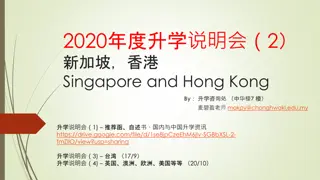Official Visit to AGD and AGO of Singapore
This document presents details of an official visit to the Accountant-General's Department (AGD) and Auditor-General's Office (AGO) of Singapore in December 2011. The purpose was to exchange knowledge on accounting policies, particularly focusing on the implementation of Accrual Basis of Accounting in the Singapore public sector. It covers the roles and responsibilities of AGD, the evolving focus of AGD, Singapore government accounting practices, and the resource accounts of ministries. The visit aimed to gather insights and best practices in financial management for the public sector.
Download Presentation

Please find below an Image/Link to download the presentation.
The content on the website is provided AS IS for your information and personal use only. It may not be sold, licensed, or shared on other websites without obtaining consent from the author.If you encounter any issues during the download, it is possible that the publisher has removed the file from their server.
You are allowed to download the files provided on this website for personal or commercial use, subject to the condition that they are used lawfully. All files are the property of their respective owners.
The content on the website is provided AS IS for your information and personal use only. It may not be sold, licensed, or shared on other websites without obtaining consent from the author.
E N D
Presentation Transcript
OFFICIAL VISIT TO AGD AND AGO OF SINGAPORE 11th- 13thDec 2011
PURPOSE The purpose of the visit was to gather knowledge and share experiences on accounting policies and systems especially in the implementation of Accrual Basis of Accounting in Singapore public sector.
ACCOUNTANT-GENERALS DEPARTMENT (AGD) DUTIES Division Function Government liabilities, assets & Treasury Responsible for the supervision and administration of the Government accounting system a. financial and accounting records and procedures for the receipt, b. custody, c. investment, d. safekeeping and payment of public moneys e. the purchase, custody and disposal of public property reserves Cash management Financial and Financial reporting Management Accounting standards Reporting Financial statements analysis Assurance and Value-for-Money (VFM) reviews Reviews Compliance reviews & internal audit services to ministries Financial Centralized financial & Administration accounting systems and Control Central paymaster
AGD : Evolving Role and Focus 2010 - Government CFO Partner in Government Finance 2005 - Training Financial Advisor Financial Leadership WOG Central Treasury 2000 - Standard Setter & System Controller People and Organisation WOG Systems Treasury Services for Ministries WOG Financial Analysis & Reviews Best Practices in Resource Management Standards and Rules 1995 Book-Keeper Technology and Processes Financial Analysis & Reviews E-services Internal Controls Systems Upgrading User Training Accounting & Financial Reporting Transaction- processing
SINGAPORE GOVERNMENT ACCOUNTING Statutory Accounts Governed by legislation such as Constitution, Financial Procedure Act, and respective Acts for Government funds Accounting Entity Organs of State and Ministries Excludes Statutory Boards and Government-owned companies Accounts prepared on cash basis for statutory reporting Offers Government most direct control over public expenditure Government cannot spend beyond what Parliament has approved
Resource Accounts - Ministries Provides information on full cost of operations and full resources of an entity Serves as a management accounting tool which allow Ministries to make better economic decisions Adapted from accrual accounting concept This process began in 1999 in stages as follows:-
Move from Cash to Accrual FY 1999 FY 1999 Introduction of Resource accounting Development of Project Costing Module Review of Resource Accounting Framework FY 2000 Limited scope audit Bar coding system to track assets FY 2005 - Full scope audit Initial implementation On Going Enhancements
The initial implementation of Resource Accounting four main strategies were deployed. Deployed AGD staff to Ministries which request support to account for their fixed assets Issued guidelines and best practices on fixed asset physical count and developing of fixed asset register Expanded helpdesk support on fixed asset issues Asset Management Support Enhance Central Accounting System Valuation Exercise Annual Audit
The initial implementation of Resource Accounting four main strategies were deployed. Tightening front-end control to ensure usage accuracy and consistency e.g. standardize useful life of asset categories in system Develop new asset management reports to facilitate tracking of fixed assets e.g. Fixed asset exception reports to flag out exceptional transactions Streamline end-to-end process in system e.g. integrated payment and asset management modules for straight- through fixed asset capitalization Asset Management Support Enhance Central Accounting System Valuation Exercise Annual Audit
The initial implementation of Resource Accounting four main strategies were deployed. Allow Ministries with infrastructural assets 3-5 years timeframe to account for these assets e.g. roads, bridges and street lightings Individual Fixed Assets task force in these Asset Management Support Ministries to account for infrastructural assets in phases Ministries held buildings without source documents to support their costs or acquisition date Develop valuation rules and accounting treatment for such assets - Assets above certain threshold needs external valuation conducted to ascertain the fair value of the assets - Assets below certain threshold needs written representation by management that the deemed cost approximates the fair value of the assets Enhance Central Accounting System Valuation Exercise Annual Audit
The initial implementation of Resource Accounting four main strategies were deployed. Auditors to express an opinion on the Ministries Resource Accounts Financial year 2000-2004: Limited scope audit of fixed assets (including projects- in-progress) balances and movements for the year Financial Year 2005 onwards: Full scope audit of all items in Resource Accounts The Resource Accounts audit is performed by private auditors appointed by each ministry and the reports must be submitted to the Accountant General s Department. Asset Management Support Enhance Central Accounting System Valuation Exercise Annual Audit
Reviewing Resource Accounting framework : Simplify requirements Focus on monitoring major capital assets Review of Framework Next Steps
CENTRAL ACCOUNTING SYSTEM (CAS) Features Purpose Supports Government accounting policies and facilitates Resource Management Designed to provide budgeting, accounting and financial management services Used by Ministries, Departments, Organs of State and a few statutory boards Provides efficiencies in integrated end-to-end business processes On-line approval of journals and payments Customized interface with purchasing system for straight- through processing Fund checking to ensure spending within budget Supports both cash and accrual accounting by providing 2 sets of ledgers cash and full-cost
Gov Budget allocated by MOF Central Accounting System NFS@Gov iBudget General Ledger Management Reports, Government Financial Statements System interface Account Receivable Account Payable Bank Reconciliation Billing Asset management Vendors@Gov E-invoice raised by Vendors
KEY LEARNING POINTS Challenges of determining opening balance of fixed assets involve the followings:- Identification of fixed assets Valuation of fixed assets Determining useful life of assets and depreciation rates According to Singapore experience it is best to fallback to historical cost because fair value is really not of much use for public sector purpose. For depreciation it is recommended to standardize the useful life of asset categories in the system with some flexibility for change.
Cont.. The central accounting system uses PeopleSoft ERP software by Oracle which is able to support two sets of General Ledger that is Cash and Resource accounting. Each transaction is initially accounted as cash transaction and later updated by batch into the accrual ledger. Challenges in getting the Ministries to use the Resource accounting information because budget is in Cash and Resource accounting served only as additional information. Treat each Ministry as a separate entity. Each Ministry has its own account. The balance sheet has no cash, only fixed assets and debtors. Cash is control centrally by Treasury.
